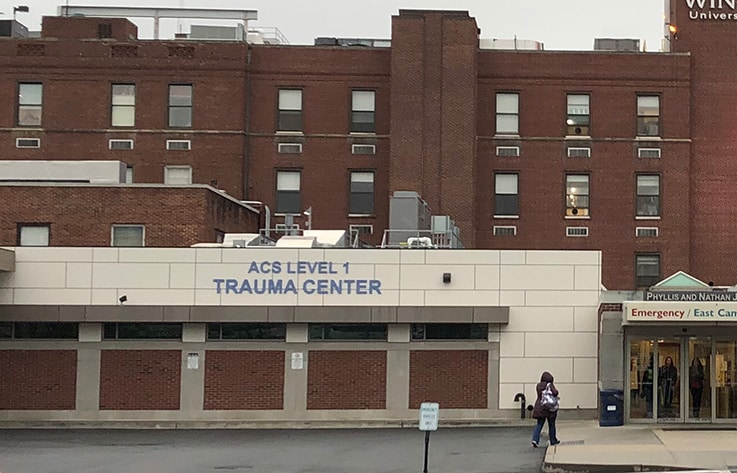Hospitals Make Fire Protection Upgrades a Priority
Hospitals in New York and elsewhere are scrambling to upgrade their fire protection systems to meet stricter federal, state and local regulations as well as looming deadlines for fully sprinklered buildings.
According to the National Fire Protection Association, fire sprinkler systems are the most effective tools for protecting life and property and controlling deadly flames and smoke. While sprinkler systems are vital in all buildings, regardless of use, they are particularly critical in hospital, which operate around the clock and provide both routine and life-saving medical care to hundreds of patients every day.
“New spaces built in the last two decades may include sprinkler systems, but older spaces often do not.”
As hospitals grew, however, fire protection systems—and sprinkler systems in particular—weren’t retrofitted everywhere. New spaces built in the last two decades may include sprinkler systems, but older spaces often do not. And, while the problem isn’t endemic to hospitals and affects all types of buildings, hospitals’ mission-critical, lifesaving operations demand that occupants’ safety is paramount.
Many hospitals across the United States have been providing this life-saving work for generations. They’ve grown as their surrounding communities have grown, adding new wings or entire buildings to support a burgeoning population and a concurrently escalating need for healthcare. Hospitals that started with a single structure decades ago now encompass an entire campus of buildings that are outfitted with the latest advances in medical care and ancillary technology.
As a result, regulatory agencies such as the Centers for Medicaid & Medicare Services, an arm of the U.S. Department of Health and Human Services, are requiring full sprinklering throughout high-rise hospitals by 2028. States and cities have issued similar mandates, pressuring hospitals to put sprinkler system upgrades at the top of their capital priority lists.
While installing state-of-the-art sprinkler systems is standard practice and fairly simple in new buildings, retrofitting sprinklers in older buildings is far more complex, for several reasons.
Critical, Continuous Care
Hospitals must continue operating around-the-clock, seven days a week. Their lifesaving work can’t be curtailed or moved elsewhere to allow for demolition or construction. Also, the steady influx of those needing emergency or acute care can’t be “scheduled,” and hospitals don’t get a break on weekends or holidays. (Often, they’re busier than ever during these times.) In addition, patients undergoing surgery or recovering from life-threatening illnesses can’t be moved or disturbed in any way to accommodate capital improvements. Instead, improvements need to be scheduled around them.

Capital improvements must be scheduled around patient care.
Unforeseen Conditions
Buildings designed and constructed decades ago didn’t need to adhere to the same guidelines for fire protection as today’s structures, and don’t many contain modern sprinkler systems. Retrofitting sprinkler systems in older buildings can be logistically difficult, as accurate as-built drawings often don’t exist or are well out-of-date. Also, walls and ceilings can already be crammed with wires and piping for other necessities, such as water, electricity, heating, cooling, oxygen and other life-saving medical tools. Finding room for new, rigid sprinkler lines can be onerous, if not impossible.

“Retrofitting sprinkler systems in older buildings can be logistically difficult…”
Compatibility with Existing Systems
Newly installed sprinkler systems must be tied into existing water and life-safety systems that themselves were installed in stages, over years. Ensuring that disparate sprinkler systems installed in different wings, different buildings or across entire campuses all work together requires a thorough understanding of each system and its distinct interoperability with another. The task also requires a thorough understanding of the types of new systems available, and those that will best meet the unique needs of both the hospital and the project.
Delicate Work
Hospitals care for the acutely ill, and patients’ fragility and their need to recover in a safe, clean and quiet environment makes installing new sprinkler systems tricky at best. The inspection, design, construction and commissioning of sprinkler systems require a level of access that often isn’t possible when hospitals are busy, and patient rooms, surgeries, diagnostic areas and even hallways are full. Also, even the most carefully planned work often must be rescheduled to accommodate emergencies, catastrophes and other unanticipated events. And, when work does commence, it must be performed with healthy modicums of quiet, cleanliness and resect, so that patients are not disturbed and their fragile conditions aren’t worsened by noise, dust or debris.
Budget Constraints
Hospitals faced with dwindling profits and declining state and federal funding are under intense financial pressure. Capital projects undertaken, likewise, are intensely scrutinized, with little funding available for schedule or budget overruns. As a result, it is vital that capital projects are well planned and designed, and that work is carefully managed and commissioned to prevent such overruns—especially when those capital projects involve improvements to existing spaces and complex tie-ins complex life-saving systems.
Regulatory Hurdles
Hospital’s capital projects often involve a host of regulatory hurdles and mandated state, local and industry-specific oversight, which can complicate budgets, schedules and the work itself. Inspections may be necessary but difficult to schedule, and penalties may be levied for missing targets, especially those associated with sprinklering. Deadlines for the work also may vary from agency to agency, as can codes and standards, and it’s important to fully understand all applicable federal, state and local requirements before planning and design begin to avoid problems later.
Collaborative Approach
The invasive nature of upgrading sprinkler systems in existing hospital spaces demands that multiple stakeholders be consulted and kept involved during the project. Project teams should include hospital management, applicable regulatory agencies, medical staff, patient advocates, building maintenance staff and community stakeholders. It’s also important that the team include project consultants who are experienced in hospital operations as well as design and construction, and who understand each institution’s unique needs, its specific constraints and concerns, and its over-arching mission to provide essential, uninterrupted medical care to the patients it serves.


